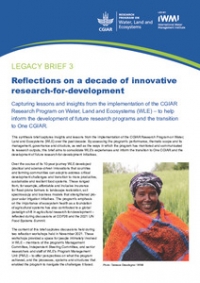Happy World Wetlands Day! Wetlands are "natural harvesters" of water and, by definition, sites where water abounds at or near the surface of the Earth. Throughout human history, they have played an important role in development and watered many great civilizations -- among them the Maya, Inca and Aztec in the Americas, the Khmer in Asia, the Marsh Arabs in Mesopotamia and the civilizations of the Nile and Niger in Africa.
Today, because of their roles in providing water, regulating river flows and improving water quality, wetlands are perceived as a vital component in the toolkit of nature-based solutions. Their natural functions have been reframed as generators of important ecosystem services that contribute, in particular, to climate change mitigation and adaptation. In Colombo, Sri Lanka, wetlands are now explicitly incorporated into the city's flood defense system, and are recognized as providing many other benefits including contributions to urban and periurban agriculture and recreation. After the partial pause on environmental damage imposed by COVID-19, more cities and countries are poised to follow Colombo's lead as they factor wetlands and other ecosystems into their green recovery.


Thinking with nature
The renewed buzz about wetlands is part of a larger turn toward nature-based solutions (also popularly known as green solutions) as a means to tackle societal challenges and achieve development goals without infringing on environmental and natural resource limits. Nature-based solutions are inspired by the processes and functioning of nature -- and many of these are solutions "for" water. They are being promoted by the UN, the World Bank and others as critical components in the management of water resources and water-related risks.
Despite the hype, though, investment in nature-based solutions remains limited. Globally it accounts for just 5% of current investment in water resources. There are many reasons why investment remains low, but lack of awareness and knowledge are paramount. Questions have been raised about both the effectiveness and the resilience of nature-based solutions in comparison to traditionally engineered infrastructure solutions like dams. And faced with these questions, evidence is lacking. A recent study of water-related solutions in Africa found that 10,633 publications discussed nature-based solutions, but only 150 (or 1.4%) of these presented empirical information on their effectiveness. Although nature-based solutions are topical and widely discussed, there is an enormous disparity between scientific research and the policy discourse.
How well do we really know our wetlands?
The disparity is easy to see in the rich research environment of wetlands. There is a dearth of quantitative information, particularly in the tropics and developing countries, on hydrological processes and how these affect water flows and water availability both seasonally and between years. This makes it difficult for planners and engineers to explicitly factor wetlands into water resource planning and management.
There are few research studies of the effectiveness of wetlands within nature-based solutions, and those that have been conducted have produced conflicting findings. Research conducted by the International Water Management Institute (IWMI) in the Zambezi River Basin, for example, found that complex interactions between a wide range of biophysical characteristics (including topography, soil, geology and vegetation) of the wetlands themselves and the landscapes in which they are located influence how wetlands affect river flows and water availability.
We do know that different wetland types have different impacts on hydrology, and where they are located in a river catchment is also important. Some wetlands (e.g. floodplains) tend to attenuate flood flows, while others (e.g. headwater wetlands) will often -- particularly when saturated -- exacerbate flooding. Because of the myriad complex processes occurring, it is often difficult to predict wetland functions in any given situation. Context is critical and generalizing performance is difficult.

Wetlands need to be a part of nature-based solutions, and these solutions need to be integral to the transformation of land and water systems for sustainable development amid a climate crisis. But if that is going to happen, more research is required to ensure that each solution represents an effective and sound investment. In the absence of sound evidence, many investments will be a waste of scarce financial and human resources and, worse, many solutions will fail to reduce risks or improve peoples' lives. Given the urgency of the complex, interrelated and seemingly intractable problems currently facing humanity, it is imperative that research on wetlands and on the efficacy of nature-based solutions in general is initiated and advanced rapidly.

---
Thrive blog is a space for independent thought and aims to stimulate discussion among sustainable agriculture researchers and the public. Blogs are facilitated by the CGIAR Research Program on Water, Land and Ecosystems (WLE) but reflect the opinions and information of the authors only and not necessarily those of WLE and its donors or partners.
WLE and partners are supported by CGIAR Trust Fund Contributors, including: ACIAR, DGIS, FCDO, SDC, Sida and others.




/index.jpg?itok=EzuBHOXY&c=feafd7f5ab7d60c363652d23929d0aee)














